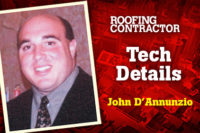
Fabricator ADPI of Avenel, N.J., installs metal
panels at the Silver Run Elementary School in Millville, N.J. Photo courtesy
of Englert Inc.
Standing seam metal roof systems have been on the U.S. market in some form for centuries. Early colonists installed copper roofs and these materials still adorn many government buildings - particularly state capitol buildings. Today standing seam metal roofs are installed on a variety of structures in both residential and commercial construction.
Standing seam metal systems are assembled in a side-by-side formation of flat metal panels that are secured in place with concealed fasteners and connected by locking the seams together. The seam formation can be completed using a field locking seam, a snap lock or a Dutch lock. The seams can be hand fabricated or formed using a seaming machine.
The most common type of standing seam metal systems are fabricated from painted galvanized steel (G 90 Steel). They can also be fabricated from painted aluminum and copper. The steel and aluminum panels come in a wide variety of colors. Standing seam metal roof systems can be applied on structures with slopes that exceed 2:12.
The metal panels can be pre-fabricated or fabricated on site by the installer. Field fabrication is a more economical method because the applicator purchases spools of flat stock metal in high volume. This method also reduces metal waste because each sheet is fabricated to site-specific sizes.
Using a self-contained portable brake on the jobsite for field fabrication of the metal panels can make the installation easier. In this method, each spool of the thin gauge metal is run through the brake and formed to specific job requirements. This includes the fabrication of the raised seams, which allow water to run off the panels without infiltrating the metal panels. The brake should be specially designed to form the interlocking panels.
The metal is fabricated to be applied vertically from the ridge of the roof to the eave. Short and long runs of metal can be fabricated to the appropriate size, reducing this step on the run during application. The panels can also be fabricated to be applied at penetrations and irregular transitions.
The panels are cut by a sharp-toothed hydraulic shear that is installed in the brake. The shear provides a clean cut that does not damage the ends of the panels. In some instances hand trimming may be required. However, most of the time the panels can be installed immediately after they are cut.

Mike Gorski, Englert’s roll-forming machine
supervisor, checks out a contractor’s new machine at a jobsite in Long Branch, N.J. Photo courtesy of Englert Inc.
Installation
Once the underlayment has been secured to the deck, application of the metal system begins with the installation of the valley metal. Once the valley metal is installed the ridge cap is applied. All of the vertical panels are applied to the ridge cap to create a uniform appearance. The roof panels are set into the ridge cap and secured to the deck with manufactured clips. The adjacent metal panel covers the clips and all fasteners from sight, giving the roof a monolithic appearance. Covering the fasteners eliminates them from exposure to the elements and reduces the possibility of water infiltration at these openings. The metal panels are installed side by side and formed together at the elevated ribs. Attachment of the seams can be conducted using hand crimping or a seaming machine.There are four types of seam configurations that have been used for conventional metal roof systems.
They are:
- Flat Seam
- Batten Seam
- Lapped Seam
- Standing Seam
As is the case with all roofing systems, installation of flashings and penetrations are the most critical points of application. These areas account for nearly 80 percent of all reported roof leaks. These areas are particularly critical on standing seam metal roof systems because the metal serves primarily as a watershed. The water shedding capacity is functionally similar to roof shingles - it relies on a steep slope to rapidly shed the water. In contrast to waterproof roofs, which are intended to function under occasional standing water, metal roofs are not designed to be completely leak-free under long-term water immersion. Therefore, waterproofing must be provided at critical junctures, such as flashings and penetrations. Flashing and penetration application should be in compliance with proper roofing procedures.
The ridge cap, valleys and vertical panels are all formed together to provide a watershed system from the elements. The metal roof systems on the market today have proven to be durable and they can provide long term waterproofing protection. Metal roof systems only require minimal maintenance. The seams must be inspected for openings and paint may be required for aesthetic purposes.
Through field fabrication, the applicator can provide metal systems in a wide variety of colors and styles that meet the aesthetic requirements of the owner. Another advantage of metal systems is that they are fire resistant and by using lighter colors they can meet LEED or Energy Star requirements.

Report Abusive Comment